Choosing the right food for your large breed dog is a cornerstone of ensuring a long, healthy, and active life. With countless options on the market, navigating the world of canine nutrition can feel overwhelming. This guide will delve into the critical aspects of feeding large dogs, from puppyhood to senior years, focusing on the “Best Dog Food For Big Dogs” and the specific nutritional needs that set them apart. Understanding these nuances is crucial for owners aiming to provide optimal care and prevent common health issues.
Understanding Nutritional Needs for Large Dogs
Dogs, regardless of size, require a comprehensive balance of nutrients, including essential vitamins, minerals, proteins, fats, and carbohydrates, to thrive. Opting for a high-quality, commercially prepared dog food is generally the most reliable and convenient method for most owners to ensure their canine companions receive adequate nutrition. These foods are formulated to meet established nutritional standards, combining various ingredients like meats, grains, vegetables, and fruits to provide easily digestible sustenance.
While the basic nutritional requirements for large dogs are similar to their smaller counterparts, there are critical exceptions. Large breed puppies, in particular, have specialized dietary needs to mitigate specific health risks. Adult large breed dogs also require careful attention to prevent conditions such as orthopedic diseases, obesity, and bloat, all of which are significantly influenced by their diet. Should you consider homemade or alternative feeding plans, consulting with a veterinarian is paramount to ensure your dog’s nutritional needs are met and any questions are thoroughly addressed.
Feeding Your Large Breed Puppy: A Critical Stage
The dietary management of large breed puppies demands particular attention. These puppies experience rapid growth spurts, continuing to develop for a longer period than smaller breeds. A puppy that weighs just one pound at birth can grow to over 150 pounds within its first 18 months. This accelerated growth rate makes them highly sensitive to caloric and nutrient intake. Imbalances, deficiencies, or excesses can negatively impact their health.
Rapid growth is not inherently healthy for large breed puppies. Excessive growth has been associated with Developmental Orthopedic Diseases (DOD), a group of conditions that includes hypertrophic osteodystrophy, osteochondrosis, retained ulnar cartilage core, panosteitis, hip dysplasia, and elbow dysplasia. Overnutrition plays a significant role in this excessive growth, making it vital to feed a large breed puppy food specifically formulated for their needs. These specialized diets differ from standard puppy foods by containing lower levels of fat, calcium, phosphorus, and Vitamin D.
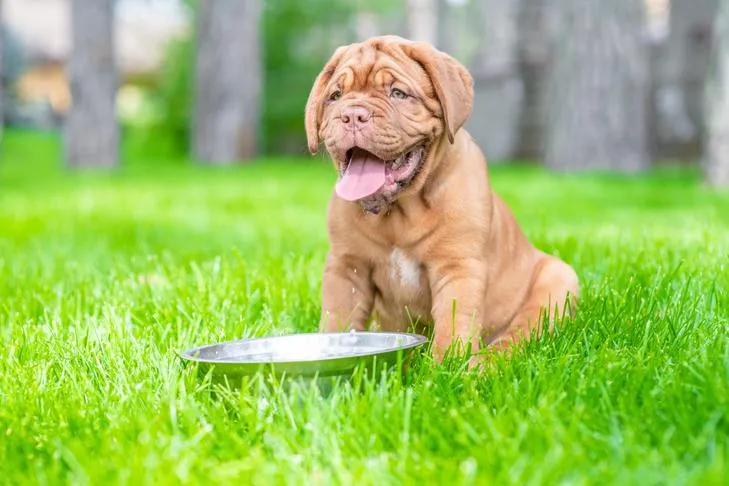 Dogue de Bordeaux puppy getting a drink of water outdoors on a hot day.
Dogue de Bordeaux puppy getting a drink of water outdoors on a hot day.
Contrary to what one might assume, large breed puppies do not necessarily need more calcium for bone development. Studies have indicated that high levels of calcium and phosphorus can contribute to DOD. Limiting their intake of these minerals, along with Vitamin D, helps reduce the risk of DOD. Furthermore, controlling their calorie intake aids in slowing their growth rate.
The quantity of food fed also plays a crucial role. Veterinarians generally advise against free-feeding large breed puppies, as this practice has also been linked to DOD. Instead, it is recommended to provide several smaller meals throughout the day and closely monitor their weight to ensure it remains within a healthy range. Your veterinarian can assist you in determining the appropriate weight range for your specific breed.
Optimal Nutrition for Adult Large Breed Dogs
Upon reaching adulthood, your large breed dog will transition to a different dietary phase. This transition is an opportune moment to discuss recommendations for the best large breed adult dog food with your veterinarian. Vets can offer invaluable insights based on your dog’s breed, size, and any existing health concerns, drawing from extensive resources to help you make an informed decision.
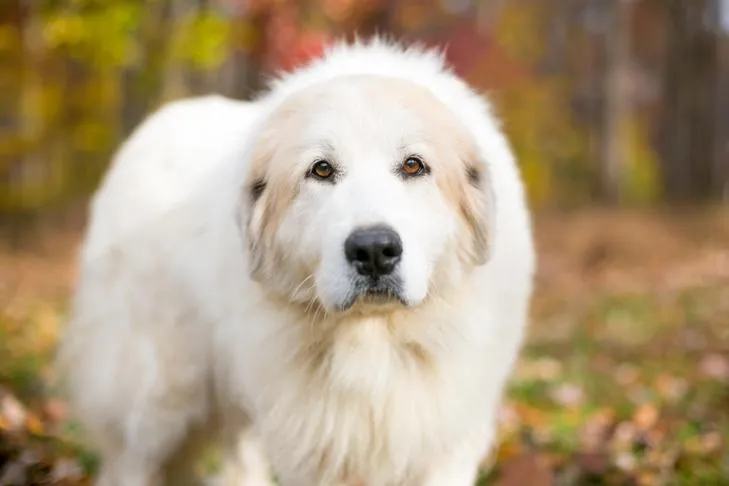 Great Pyrenees head portrait outdoors in the fall.
Great Pyrenees head portrait outdoors in the fall.
Catering to the Needs of Senior Large Breed Dogs
Dog food designed for senior dogs is a relatively recent development. As of now, there isn’t an officially approved “senior stage” by organizations like AAFCO or the FDA, meaning that senior dog foods available commercially may not have undergone the same stringent testing as foods for other life stages. However, this does not preclude them from being a beneficial option for your senior canine companion. Adult, all-life-stage, and senior formulas can all be suitable.
Senior dogs often develop age-related health issues that necessitate veterinary attention and specialized care. In some cases, a prescription diet might be the ideal choice for large breed seniors, as these veterinary-approved foods are specifically formulated to address their unique needs. Consulting your vet is essential to determine the most appropriate food for your senior large breed dog.
Common Health Concerns for Large Breed Dogs
Large and giant breed dogs are predisposed to a range of health issues that owners should be aware of. Understanding these concerns can help in selecting the best nutrition and lifestyle choices to mitigate risks.
Orthopedic Disease in Dogs
Large and giant breeds are more susceptible to musculoskeletal and orthopedic disorders, including hip dysplasia, arthritis, and osteochondrosis. These conditions are influenced by genetics, growth rate, exercise, and nutrition. While you cannot control hereditary factors beyond choosing a puppy from a responsible breeder, you have significant influence over growth rate, exercise, and nutrition. Feeding an appropriate large breed puppy diet can decrease the risk of DOD. In adulthood, consistent monitoring of diet and exercise is crucial for maintaining a healthy weight. A high-quality diet with the correct nutrient balance for large breeds supports joint, muscle, and bone health. Many adult large breed formulas also include joint supplements like glucosamine.
Obesity in Dogs
Approximately 53 percent of American dogs are overweight or obese. Obesity poses a particular threat to large breed dogs, as it amplifies their risk of developing orthopedic diseases. The excess weight places undue stress on their joints, muscles, and bones, potentially leading to serious mobility issues and a reduced quality of life. Obesity has also been linked to other significant health problems, including Type 2 diabetes, kidney disease, and high blood pressure.
Bloat in Dogs
Gastric dilatation-volvulus (GDV), commonly known as bloat, is a serious and potentially fatal condition affecting large and giant breed dogs. It occurs when gas rapidly accumulates in the stomach, with no means of escape, and can be lethal within hours. While medical interventions exist, prevention remains the most effective strategy. To reduce your dog’s risk of bloat:
- Feed multiple smaller meals daily rather than one large meal.
- Feed from floor-level bowls, avoiding raised feeders.
- Avoid foods with high fat content (check for oils and fats within the first four ingredients).
- Opt for foods with large kibble.
- Refrain from strenuous exercise for 1-2 hours after eating.
Choosing a large breed formula from a reputable manufacturer is often the best preventative measure. Don’t hesitate to ask your veterinarian for their specific recommendations.
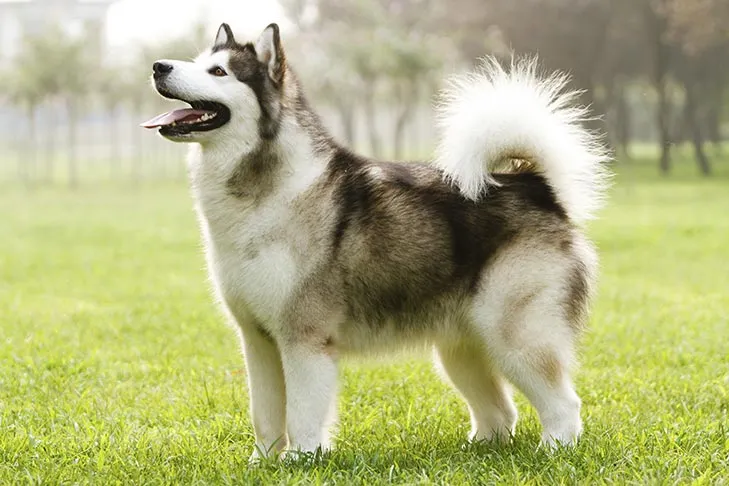 Alaskan Malamute standing in the grass.
Alaskan Malamute standing in the grass.
Types of Large-Breed Dog Food
When selecting food for your large breed, you’ll encounter two primary categories: dry and wet dog food. Each offers distinct advantages.
Dry Dog Food
Dry dog food is a popular and often the most economical choice for dogs. For large breeds, it offers convenience in storage and transport, whether traveling or using boarding services. The texture of dry kibble can also aid in reducing plaque and tartar buildup on teeth. Furthermore, dry food pieces can double as treats for training or rewarding your dog. Choosing a dry dog food for large breeds ensures it’s formulated to meet their specific needs.
Wet Dog Food
Due to its high moisture content, wet dog food can be beneficial for dogs who are not drinking enough water. Its soft texture makes it easy to chew, making it an excellent option for senior dogs or those with dental issues. With a higher water content, wet food for large dogs is typically lower in calories compared to dry food.
Navigating Dog Food Labels
Dog food labels provide valuable information, but they can sometimes be complex. Even when looking for large breed-specific options, the selection remains vast. Here are key points to consider:
- “Complete and Balanced”: Always look for this label, indicating the food meets established nutritional profiles.
- Clinically Tested: Prefer foods that have undergone clinical trials and testing.
- Avoid Unregulated Claims: Phrases like “all-natural” or “human-grade ingredients” are not regulated and can be misleading.
- Ingredient Order: Be cautious of foods listing oils and fats within the first four ingredients.
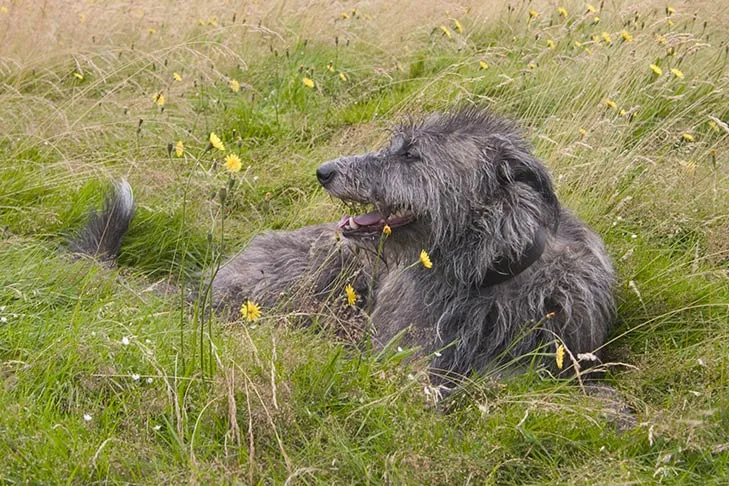 Scottish Deerhound laying in tall grasses.
Scottish Deerhound laying in tall grasses.
While labels don’t detail ingredient quality, they do indicate the sources of protein and carbohydrates. This information is particularly useful for dogs with food allergies or sensitivities and for owners seeking specific protein sources.
Determining Feeding Amounts for Large Dogs
There isn’t a single answer to how much to feed a large breed dog, as each dog’s caloric requirements are unique. The feeding guidelines on the food packaging serve as a starting point, but adjustments may be necessary. A veterinarian can help you determine the appropriate amount by assessing your dog’s body condition score (BCS). This score helps gauge if your dog is at an ideal weight, overweight, or underweight, guiding necessary adjustments to their food intake.
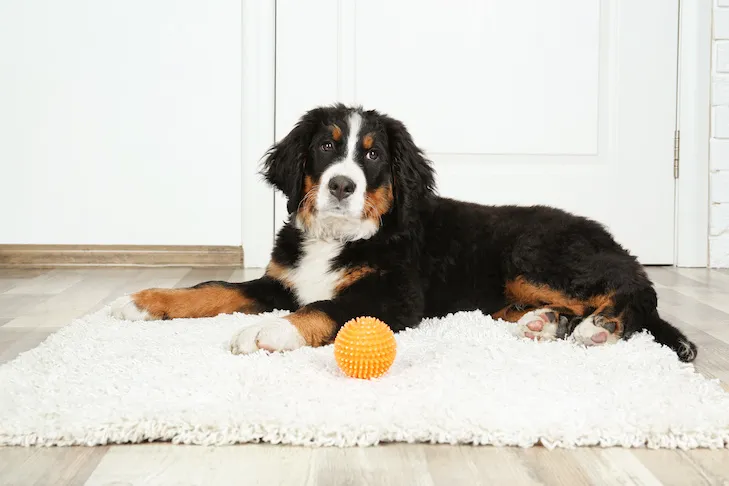 Cute funny dog lying on rug near door at home
Cute funny dog lying on rug near door at home
The Cost of Large Breed Dog Food
Large breed dogs consume a significant amount of food, making their dietary costs higher than those of smaller dogs. This is an important factor for anyone considering bringing a large breed puppy into their home. While it may be tempting to opt for less expensive food to save money, it’s crucial to investigate the quality of any dog food. Investing in high-quality food is investing in your pet’s health. Poor-quality food can lead to unforeseen health issues and increased veterinary costs down the line.
What Truly Is the Best Food for Large Breeds?
There isn’t a single brand that stands out as the definitive “best dog food for big dogs.” Ultimately, the responsibility lies with the owner to research large breed nutrition and identify the most suitable food for their individual dog. The most effective approach is to consult with your veterinarian. They can assist you in developing a lifelong nutrition plan tailored to your dog’s specific life stages, thereby giving them the best opportunity for a long and healthy existence.
